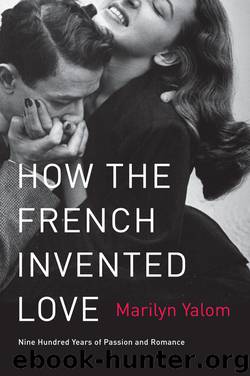How the French Invented Love by Marilyn Yalom

Author:Marilyn Yalom
Language: eng
Format: epub
Publisher: HarperCollins
CHAPTER NINE
Romantic Love Deflated
Madame Bovary
THE MATERIAL OF HER RIDING HABIT CAUGHT ON HIS VELVET COAT. SHE TIPPED BACK HER HEAD, HER WHITE THROAT SWELLED WITH A SIGH; AND WEAKENED, BATHED IN TEARS, HIDING HER FACE, WITH A LONG TREMOR SHE GAVE HERSELF UP TO HIM.
Gustave Flaubert, Madame Bovary, 1857
Flaubert dissecting the heart of Madame Bovary. Caricature by Achille Lemot. From “Parodie,” 1869. Paris: Bibliothèque Nationale.
In the 1850s, when Flaubert was writing Madame Bovary, he corresponded regularly with his Parisian mistress, the poet Louise Colet. From the house that he shared with his mother at Croisset in Normandy, he expressed the torments of a writer dedicated to the religion of art. Sometimes he barely eked out a line a day, and often Emma Bovary literally made him sick. Why would anyone want to write a novel about an overly romantic woman who marries a feckless country doctor, has two affairs and mounting debts, and ultimately commits suicide? Flaubert had his reasons. As he noted in his letter of April 12, 1854, to Colet: “A terrible reaction is taking place in the modern conscience against what we call love. . . . Our century looks through a magnifying glass and dissects on its operating table the little flower of Sentiment, which smelled so good in the past!”1
Times had changed since romantics exalted all-consuming love. Realists like Flaubert were determined to deflate the romantic ideal, which he attributed to the banality of everyday existence. His commitment to portraying people “objectively,” with all their defects and base cravings, contributed substantially to the French de-romanticization of love. It even left him vulnerable to the charge of indecency. A government trial against Madame Bovary was instituted on the grounds that it was “an outrage to public and religious morality,” but fortunately for Flaubert, who was at risk for imprisonment and a heavy fine, he was acquitted on February 6, 1857. (Just as I was writing this chapter, National Public Radio reminded its listeners that it was the 154th anniversary of Flaubert’s acquittal. How about that!) The prosecution had the expected results of making Flaubert better known and increasing book sales. With the notoriety surrounding Madame Bovary, the chic French view of love shifted from illusion to disillusion.
Flaubert and his fellow realists—Guy de Maupassant, the Goncourt brothers, Émile Zola—were out to prove that love was nothing more than a trick the mind plays on itself. As Stendhal had observed a generation earlier in De l’amour (On Love, 1822), when we fall in love, we embellish the beloved person with all the good qualities we want that person to have. Stendhal’s word for that process was cristallisation, a term he derived from the formation of diamondlike crystals on a tree branch when it is left in a salt mine for two or three months.2 In Madame Bovary, Flaubert set out to show how cristallisation worked within the psyche of a young woman, successively infatuated with two men who were not her husband.
But it would be wrong to think of Flaubert solely as a realist—a term he himself repudiated later in life.
Download
This site does not store any files on its server. We only index and link to content provided by other sites. Please contact the content providers to delete copyright contents if any and email us, we'll remove relevant links or contents immediately.
| Codependency | Conflict Management |
| Dating | Divorce |
| Friendship | Interpersonal Relations |
| Love & Loss | Love & Romance |
| Marriage | Mate Seeking |
The 5 Love Languages: The Secret to Love That Lasts by Gary Chapman(9585)
Doing It: Let's Talk About Sex... by Hannah Witton(9186)
Should I Stay or Should I Go? by Ramani Durvasula(7560)
The Road Less Traveled by M. Scott Peck(7522)
The Lost Art of Listening by Michael P. Nichols(7403)
Daring Greatly by Brene Brown(6443)
Beartown by Fredrik Backman(5594)
We Need to Talk by Celeste Headlee(5542)
Men In Love by Nancy Friday(5155)
The Rules Do Not Apply by Ariel Levy(4842)
The State of Affairs by Esther Perel(4634)
How To Win Friends and Influence People by Dale Carnegie(4441)
Reflections Of A Man by Mr. Amari Soul(4233)
Pillow Thoughts by Courtney Peppernell(4207)
The Ethical Slut by Janet W. Hardy(4172)
Algedonic by r.h. Sin(4009)
He's Just Not That Into You by Greg Behrendt & Liz Tuccillo(3830)
I Love You But I Don't Trust You by Mira Kirshenbaum(3805)
Surrounded by Idiots by Thomas Erikson(3770)
